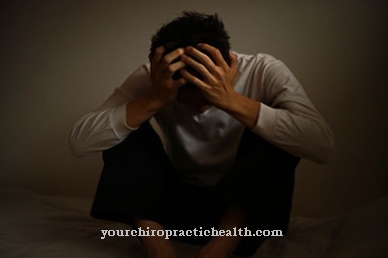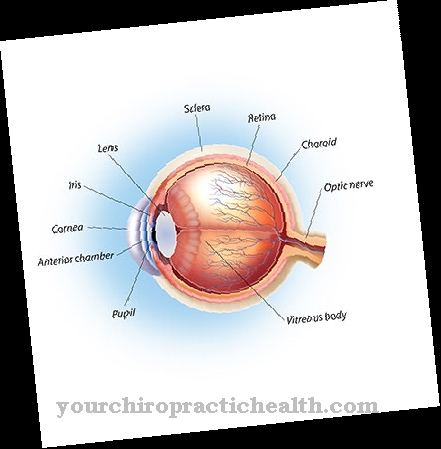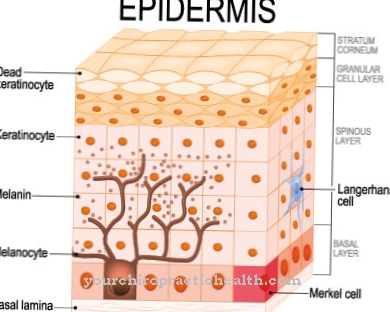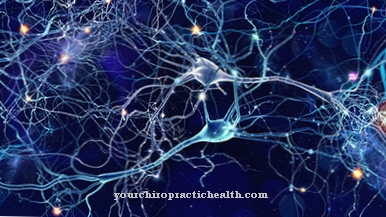A Ovarian cyst or Ovarian cyst is a fluid-filled bladder on the ovary (ovary). It is known medically as an ovarian cyst.
What is an ovarian cyst?

Ovarian cystsOvarian cysts are often caused by hormonal changes in the body and often resolve on their own. Only if they become so large that they cause pain or press on other organs, or are diagnosed as malignant, do they need to be surgically removed.
An ovarian cyst is a blister on the ovary that contains fluid. It can have a diameter of 1-10 cm. Cyst is the medical term for a tumor that is hollow inside and filled with fluid.
Ovarian cysts form directly on the ovary. The female ovaries are located on the left and right of the uterus in the lower abdomen.
causes
There are two types of ovarian cysts: the functional ovarian cyst and the retention cyst. Each of these cysts has a different cause. The functional ovarian cyst is the more common type. It is caused by hormonal fluctuations, which are caused either by incorrectly controlled hormone production in the body or by therapeutic hormone treatment.
Endometriosis (disease of the lining of the uterus) can also lead to the formation of ovarian cysts. The reason for retention cysts (retention = holding back) is an accumulation of secretion that cannot drain off due to blockage.
The retention cysts that develop on the ovaries are usually the so-called dermoid cysts. They contain an oily liquid and various types of cell tissue. They mainly occur in young women. This type of ovarian cyst is a malformation and is congenital.
Symptoms, ailments & signs
An ovarian cyst is usually only a few centimeters in size and does not cause any symptoms. When the ovarian cyst reaches a certain size, various symptoms can arise. The pressure on the neighboring organs results in dull or pulling pelvic pain.
These are accompanied by a frequent urge to urinate and emptying disorders of the bowel. In individual cases, a cyst causes circulatory disorders, which can be expressed as sensory disorders, twitching and other, mostly unspecific symptoms. In addition, back pain and pain during sexual intercourse can occur in connection with an ovarian cyst. Menstrual cramps can also occur.
Often the cycle is disturbed or runs irregularly, and severe menstrual pain is also possible. With complications like bleeding or rupture, an ovarian cyst can cause sudden, colicky pain. In addition, the typical fever symptoms can occur, i.e. sweating, chills and an increasing feeling of illness.
If left untreated, the cyst can grow in size and the symptoms become worse. An ovarian cyst cannot be externally recognized by a layperson. However, the doctor notes a slight bump in the skin in the area of the abdomen. If this bump is touched, acute pain usually occurs.
Diagnosis & course
An ovarian cyst does not cause any symptoms as long as it is small and does not press on other organs. Such a small cyst is usually discovered by chance during a routine gynecological examination. If the ovarian cyst grows, it can cause pain in the lower abdomen. Spotting, frequent urination, discomfort when emptying the bowel, back pain or pain during sexual intercourse are also possible.
The monthly cycle can be disturbed and irregular, and ovarian cysts sometimes cause more pain during menstruation. In order to be able to make a diagnosis, the doctor will first palpate the abdomen from the outside and carry out a vaginal palpation examination.
Any palpable findings can be confirmed with an ultrasound examination. If an ovarian cyst has formed in older women who are already through menopause, the blood is examined for a tumor marker in order to be able to rule out a malignant tumor.
Complications
Ovarian cysts (ovarian cysts) are usually not associated with serious complications. In about ten percent of the cases, however, a rupture occurs, i.e. the ovarian cyst bursts. The bursting often occurs as a result of external influences, for example during sport or during an examination by the gynecologist. However, ovarian cysts can burst spontaneously without any external assistance. This process is usually harmless.
In individual cases, however, the rupture can rupture vessels, so that bleeding occurs in the creek space, which necessitates surgery. If the blood runs inside the abdomen, this usually leads to a breakdown of the circulatory system. In the event of severe injuries, dangerous blood loss is also possible.
Another complication that can occur with ovarian cysts is stem rotation. Larger ovarian cysts, especially those resulting from endometriosis, can be linked to the ovaries via a vascular pedicle. Sudden jerky movements, for example during sport, but also during sexual intercourse, can cause this shaft to be rotated.
The blood supply to the cyst tissue and possibly also to the ovaries themselves is severely restricted or completely prevented. The cells that are no longer adequately supplied with blood begin to die. In these cases, surgery is required. Otherwise, decomposition processes could trigger peritonitis or blood poisoning.
When should you go to the doctor?
Ovarian cysts are common and in most cases they are benign. But if they cause discomfort, e.g. B. severe abdominal discomfort, it is better to see a gynecologist to avoid complications that can be life threatening. An ovarian cyst can burst and bleed into the abdomen.
It can also turn once around its own axis with a twist of the stem and thereby constrict blood vessels that supply the ovaries or, in worse cases, even tear them off. Often stem rotations are caused by jerky movements. They are associated with severe pain. If there are also nausea, sweats and a racing pulse, emergency surgery is usually necessary.
As a precaution, even if cysts cause bleeding beyond your period, you should always see a doctor to clarify the cause. Even if cysts are benign in most cases, they can also degenerate into malignant form and promote ovarian cancer. Especially if there is still a familial risk, it makes sense to observe cysts over a longer period of time. So-called chocolate cysts in the context of endometriosis should also be observed and treated if necessary. They act like the uterus and bleed during menstruation. However, the blood cannot drain there and can lead to crusts and painful adhesions in the abdomen.
Doctors & therapists in your area
Treatment & Therapy
Treatment for an ovarian cyst depends on the type of cyst. In young women, ovarian cysts are usually harmless functional cysts that usually resolve on their own. First you wait and watch how the cyst develops and whether it shrinks again and disappears completely.
Sometimes hormonal drugs, such as birth control pills, are prescribed to help shrink the ovarian cyst. Only when it continues to grow and becomes so large that it presses on other organs is it surgically removed. Ovarian cysts that appear in older women after menopause should be carefully examined. To do this, the doctor takes tissue from the ovarian cyst by means of laparoscopy, i.e. through small incisions in the abdominal wall and under the control of a camera, and has it examined in the laboratory.
The patient is under general anesthesia during the procedure. If the tissue is malignant, the cyst is surgically removed. For ovarian cysts caused by endometriosis, hormonal therapy is tried first. If this does not work, the doctor will also remove these ovarian cysts surgically in a laparoscopy.
Outlook & forecast
The ovarian cyst generally has a good prognosis. In over 90% of the affected patients, the cyst heals independently without further medical intervention. There is no symptoms and a full recovery.
In some cases, despite the favorable prospect, complications arise. The cyst can tear, tear, or twist. This can already be done during a palpation examination, sexual or vigorous physical activity. Pain sets in and light bleeding is possible. Often the complaints are not very worrying. However, if there is bleeding, it can develop into the abdomen. Surgical intervention is necessary to prevent further illnesses from occurring.
If the operation proceeds without further complications, the patient can be discharged from treatment within a short time. Although the ovarian cyst has a good chance of healing, one or more cysts can develop at any time. In very rare cases, the ovarian cyst can develop into a malignant tumor and cause ovarian cancer. Without treatment, it is progressive and can lead to the early death of the patient. With medical care, the prognosis depends on the stage of the disease and the effectiveness of the cancer therapy. Lifelong consequential damage such as infertility is possible.
prevention
Dermoid cysts cannot be prevented because they are congenital. In the case of functional ovarian cysts, hormonal prevention would be conceivable. However, since these ovarian cysts are harmless and usually regress on their own, the burden on the body from hormonal preparations would be greater than the impairment caused by the formation of an ovarian cyst.
If the cysts are caused by endometriosis, the hormones administered during treatment not only have a therapeutic effect, but also act as prophylaxis. This means that the hormones shrink the existing cysts and also prevent new ovarian cysts from forming.
Aftercare
In the case of an ovarian cyst, follow-up measures are very limited in most cases. The person concerned is primarily dependent on a complete treatment of this disease so that there are no further cysts or further complications on the body. Whether the ovarian cyst will reduce the life expectancy of the person affected cannot be universally predicted.
In most cases, the ovarian cyst can be removed relatively easily through surgery. This is not always necessary, so surgery is only done if the ovarian cyst has spread or is malignant. After the procedure, the person affected should definitely rest and take care of their body. Do not make any effort or stressful activities.
You should also refrain from sexual intercourse in the time after the removal in order not to unnecessarily irritate the region. In many cases, regular examinations by a doctor are necessary and useful even after an ovarian cyst has been successfully removed. In the drug treatment of this disease, regular and correct use of the medication should be ensured, and the correct dosage should also be observed.
You can do that yourself
Before self-treatment takes place, those affected should have the type of cyst determined by a gynecologist. The subsequent therapy is based on this.
Since most cysts are harmless and often go away on their own, affected women can try to alleviate the symptoms that occur. Nature supplies numerous medicinal plants for complaints such as abdominal pain or frequent urination. Mention should be made here of monk's pepper or the herb lady's mantle. These are mostly offered as tea. Drinking several cups a day can help alleviate slight discomfort. Monk's pepper also regulates fluctuations in the monthly cycle.
If the pain occurs for a limited time, it is also possible to take an over-the-counter pain reliever such as ibuprofen (analgesic). Furthermore, cold or heat applications can be tried. Those affected react differently to this. In general, everything that is good is allowed.
Since many women also complain of flatulence - mostly the intestine as an adjacent organ is also affected - it is advisable to reduce flatulence foods. To counteract the frequent urge to urinate, preparations made from pumpkin seeds can help. If sexual intercourse is painful, it should initially be avoided.
If the cyst is caused by a hormonal imbalance, low-dose birth control pills can be considered. Since taking them can also be associated with side effects, the advantages and disadvantages should be carefully considered. If you are already taking an estrogen preparation, changing the drug could be a possibility.













.jpg)

.jpg)
.jpg)











.jpg)